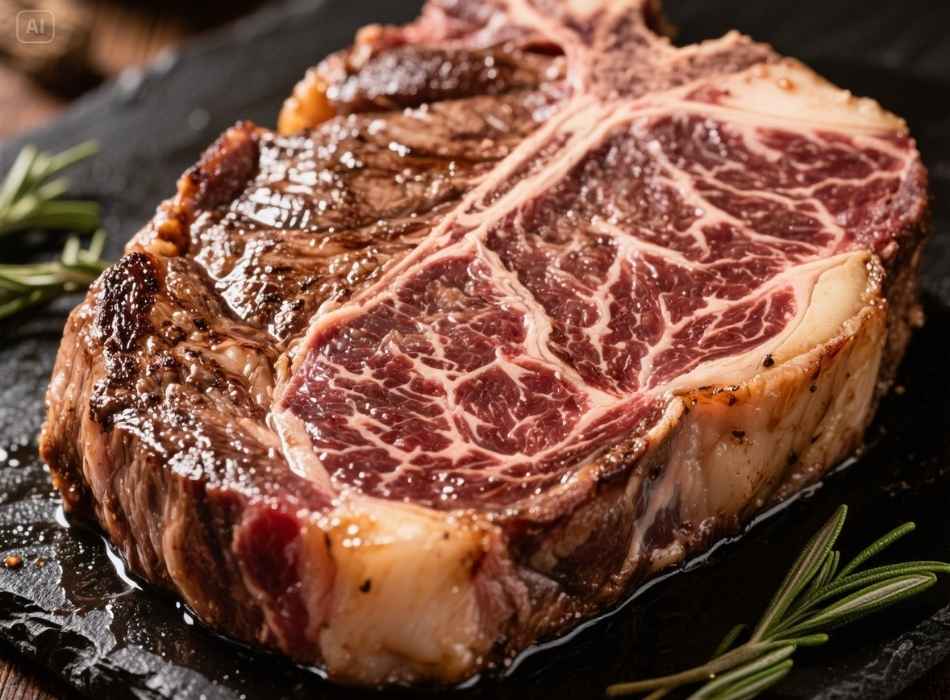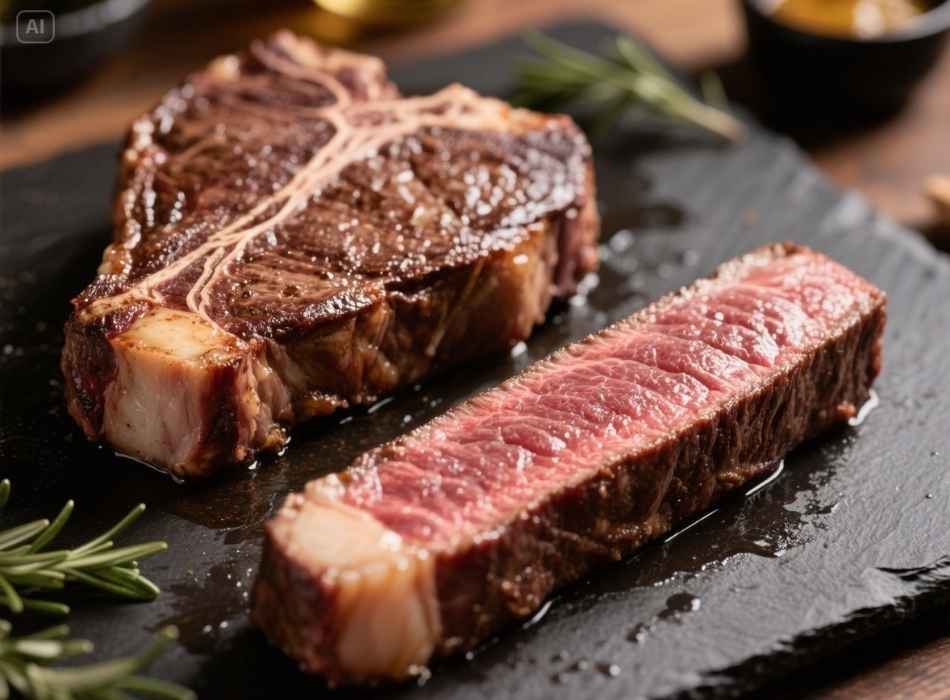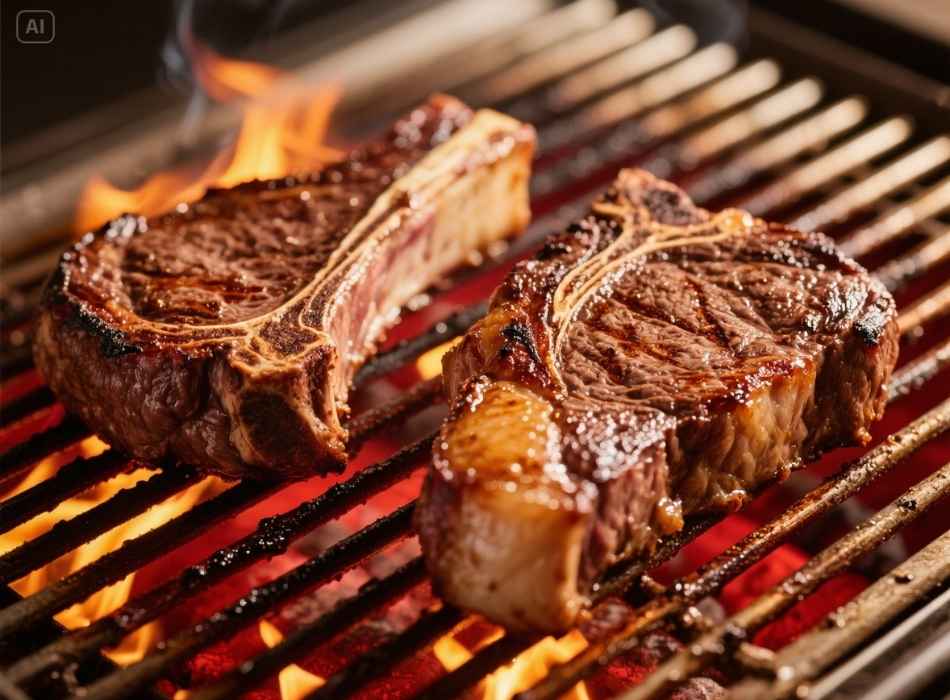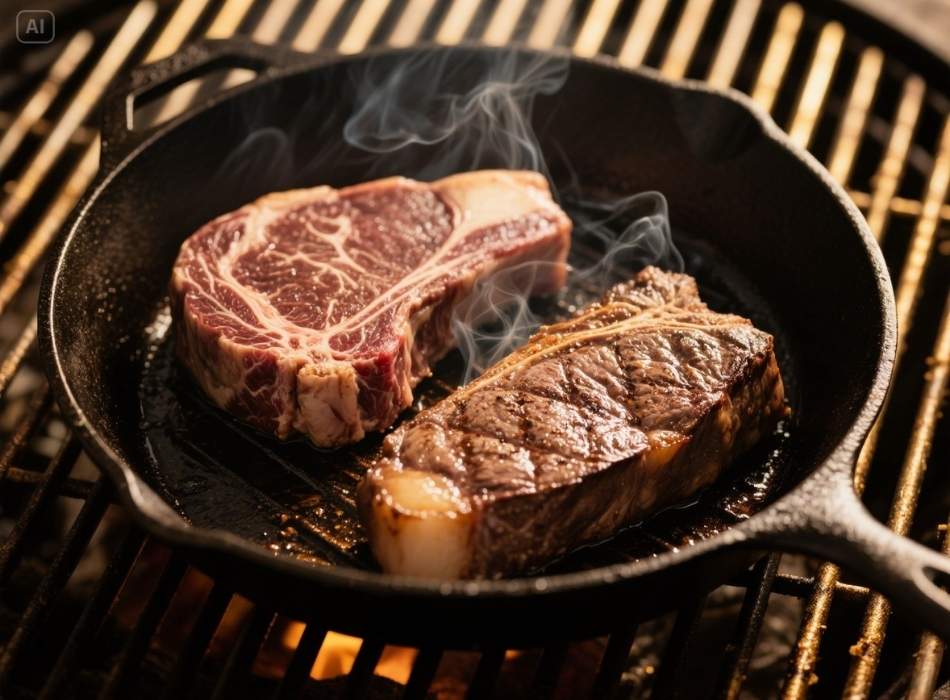When it comes to steaks, the debate between ribeye and New York strip often takes centre stage. Both cuts are renowned for their exceptional flavour and texture, but they cater to slightly different tastes and preferences. Whether you’re a grill master hoping to perfect your next barbecue or a steak enthusiast seeking the ideal restaurant order, understanding the differences between ribeye and New York strip can help you make a more informed (and delicious) choice.
This guide will break down everything you need to know about these premium cuts. We’ll explore their characteristics, compare their flavour profiles, cooking methods, and nutritional aspects, and finally help you decide which cut best suits your palate.
What Is a Ribeye?
The ribeye comes from the rib section of the cow, one of the most prized areas of the animal. It is synonymous with richness and tenderness, thanks to its high-fat content. A ribeye can be sold with the bone attached (bone-in ribeye) or without it (boneless ribeye).
Key Characteristics of Ribeye:

- Marbling: Ribeyes are celebrated for their abundant marbling, the intramuscular fat that melts during cooking to create a buttery texture and bold flavour.
- Texture: Due to its marbling, the ribeye is incredibly tender, making it one of the more luxurious steak cuts.
- Rich Flavor: The fat content doesn’t just enhance tenderness; it infuses the meat with a distinct, savoury richness.
What Is a New York Strip?
The New York strip is cut from the short loin, located along the back of the cow. This area gets less exercise than other sections, which contributes to its tenderness. Often referred to as a “strip steak,” this cut is known for its fine balance between tenderness and chewiness.
Key Characteristics of the New York Strip:
- Leaner than Ribeye: While it still has some marbling, the New York strip has less fat compared to a ribeye.
- Firm Texture: The fine grain of the strip steak offers a more substantial chew, which many steak lovers enjoy.
- Bold Flavor: Although leaner than the ribeye, the strip steak delivers an intensely beefy flavour that shines when properly cooked.
Ribeye vs. New York Strip: What Sets Them Apart?

1. Flavor
- Ribeye: If you’re after an indulgently rich and juicy steak, the ribeye is for you. Its fat content delivers a flavour-packed bite that feels almost decadent.
- New York Strip: For a purer, beef-forward flavour without as much richness, the New York Strip is the better choice. Its leaner profile highlights the natural taste of the steak without being overly fatty.
2. Texture
- Ribeye: The high marbling creates a tender, almost buttery texture. This steak practically melts in your mouth.
- New York Strip: The strip steak strikes a balance between tenderness and a firmer, heartier chew. The fine grain of the meat gives it a satisfying bite.
3. Marbling
- Ribeye: Known as the king of marbling, the ribeye’s fat content is its hallmark. This results in not only tenderness but also a juicier cut.
- New York Strip: While it’s marbled, the strip has less intramuscular fat, making it leaner overall.

4. Cooking Methods
- Ribeye:
- Best cooked using high heat to render the fat, such as grilling, broiling, or pan-searing.
- Bone-in ribeyes are excellent for the reverse-sear method.
- New York Strip:
- It’s ideal for a quick search and grilling.
- Its leaner structure benefits from a good crust, so make sure to cook it over high direct heat.
5. Price
- Ribeye: The luxurious marbling makes the ribeye one of the pricier steak options, but it’s worth the splurge for its flavour and texture.
- New York Strip: Slightly more affordable than ribeye, the strip still offers premium quality without reaching quite the same price point.
Nutritional Comparison
While both cuts are excellent sources of protein, vitamins, and minerals, their fat content creates slight differences in their nutritional profiles.
| Nutrient | Ribeye (per 3 oz) | New York Strip (per 3 oz) |
|---|---|---|
| Calories | ~240 | ~200 |
| Protein | ~20g | ~24g |
| Total Fat | ~18g | ~12g |
| Saturated Fat | ~8g | ~5g |
Key Takeaways:
- Ribeye is richer in calories and fat, which contributes to its deep flavour.
- New York Strip is leaner and slightly higher in protein, which may appeal to those seeking a healthier option without sacrificing taste.
Which Cut Should You Choose?
Your choice ultimately comes down to personal preference and the occasion:
- Opt for Ribeye if:
- You love a rich, decadent flavour.
- Tenderness is your top priority.
- You’re planning for a celebratory meal where indulgence is key.
- Opt for New York Strip if:
- You enjoy a leaner cut with a firm, satisfying texture.
- You want a steak that’s versatile for various cooking methods.
- You’re looking for a less fatty option while still enjoying a bold, beefy flavour.
Pro Tips for Cooking Both Cuts
- Season Generously: A simple seasoning of kosher salt and freshly cracked black pepper is all you need to enhance the natural flavours.
- Rest Your Steak: Allow your steak to rest for at least 5 minutes after cooking to lock in the juices.
- Use a Meat Thermometer:
- Medium rare (warm red centre): 130°F
- Medium (warm pink centre): 140°F
- Medium well (slightly pink centre): 150°F
Elevate Your Steak Game
Whether you go for the indulgent ribeye or the bold New York strip, both cuts offer an exquisite steak experience when cooked properly. By understanding the defining traits of each cut, you can be confident that your next steak night will be a resounding success.
Looking for more tips to master the art of steak preparation? Subscribe to our newsletter for exclusive recipes, cooking techniques, and insider tips from top chefs!








